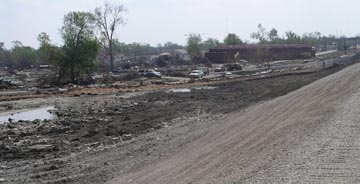Seeing is really believing
Posted by Heading Out on October 12, 2005 - 12:57am
But there is a strong sense that the town is coming back, you can get red beans and rice on Bourbon Street (it being Monday) - even though it is in a plastic container, because they prefer to use the limited power to cool the beer, rather than run dishwashers. And there were some tourists and shops were beginning to open. In part that is also true of the nearby oil industry, the oil pipelines are now largely checked and in good shape, and there were three workboats down at Venice that seemed to be stocking up and ready to head back out into the Gulf, and to begin rebuilding the oil supply infrastructure out there. Not that there is not a lot that has to be done.
Back at the time of the Hurricane I had raised a question as to whether it was better to leave the tanks in an oil farm full or empty.
I think that question is now answered, with the right answer being apparently full. The tank has been lifted and set down across the feed lines into the terminal at Port Sulphur.
And as a further comment to my earlier discussion about levees and floodwalls. Note the difference that a barge makes.
Note that the earthen levee has held the barge. It is still on the water side of the levee, and has not induced a breech at that point.
In contrast at the Industrial Canal breech in the city, you have to look closely at the picture to see the floodwall pilings stretched across the ground in an arc from the end of the remaining floodwall (it is now replaced with a levee) and the barge is beyond, on the land side of what was a barrier. 
The concrete wall that provided the visual evidence of the floodwall is fractured and all along the breech the piling was pulled out of the ground and carried far into the opening created by the force of the water, and possibly also the barge.




- Should storage tanks be anchored with chains or cables so that they can only float within the boundaries of their moats?
- Should they be filled with water to plant them solidly (and would the fuel within be salvageable afterward)?
- Internal water bags which can be filled without mixing with the tank contents? (Works for all kinds of tanks.)
- Should e.g. propane tanks be placed within pilings which allow them to float up without floating away?
Lack of fuel was a serious problem in the aftermath of the hurricanes. Fixing the infrastructure so that it is harder to damage and can be brought right back into service would have speeded the recovery efforts, from faster relief and law enforcement right on up.